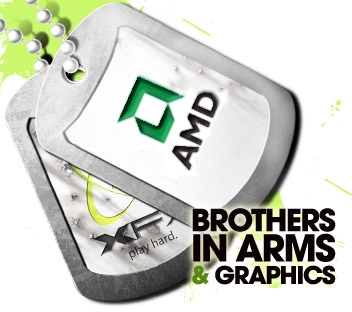XFX and AMD Cuddle Up, NVIDIA Frowns
XFX, the long-time manufacturer of NVIDIA-based graphics cards and motherboards, announced that it is now an official AMD technology partner. Starting early next year, XFX will no longer be exclusive to NVIDIA. Instead, the company will also begin selling AMD Radeon HD 4000 series graphics cards alongside its NVIDIA lineup.
According to Rick Bergman, senior vice president and general manager of AMD's Graphics Products Group, “In the world of PC gaming, XFX is synonymous with the extreme performance that enthusiasts crave. Their decision to partner with AMD and launch AMD GPU-based XFX graphics cards, including the ATI Radeon HD 4870 X2, widely regarded as the world’s fastest graphics card by technology enthusiasts around the world, speaks to the level of excellence achieved by the ATI Radeon HD 4000 series.”
Lets take a second to review current market offerings from NVIDIA and AMD to see exactly where the two companies stand at the moment. Please find below a chart comparing current prices and estimated Futuremark scores of a select few performance graphics cards. As of December 16, 2008, the AMD Radeon HD 4870 X2 graphics card ranked highest on Futuremark's list of Top Performance Graphics Cards. Although Futuremark's estimated graphics scores may not be the best representation of a particular graphics card's performance, it is a popular means of doing so.
| Graphics Card | Price atNewegg.com | Futuremark Estimated Graphics Score | Performance to Price Ratio |
|---|---|---|---|
| MSI Geforce GTX 280 /w 1 GB | $329 after $40 MIR | 11272 | 34.16 |
| XFX Geforce GTX 280 /w 1 GB | $359after $50 MIR | 11272 | 31.31 |
| EVGA Geforce GTX 260 Core 192 | $219 | 8231 | 37.41 |
| XFX Geforce GTX 260 Core 216 | $259 | 8231 | 31.66 |
| Sapphire Radeon HD 4870 X2 /w 2 GB | $469 after $20 MIR | 13977 | 29.74 |
| Sapphire Radeon HD 4870 /w 512 MB | $179 after $20 MIR | 8428 | 46.82 |
The AMD Radeon HD 4870 X2 is shown to offer the greatest performance, but it also comes with a premium price tag. The AMD Radeon HD 4870 has the best performance to price ratio, but the selected version used in this comparison comes equipped with only 512 MB of memory, which might be considered unfair. Of course, the Futuremark score does not state how much memory each graphics card is equipped with.
Overall, we see that the Geforce GTX 200 series still manages to offer a high-end performance at competitive prices when including the mail-in rebates. Within this month, NVIDIA is also rumored to be launching its Geforce GTX 295 graphics card, which may help return the performance crown to the company.
Although XFX is not dropping NVIDIA as a partner, the news really does not speak well for NVIDIA. XFX also recently stopped producing NVIDIA-only based motherboards. The company XFX now produces motherboards with Intel chipsets too. XFX might just be expanding its options in the market, but it is not the first exclusive NVIDIA partner in recent months to also start producing AMD-based graphics cards.
NVIDIA posted better than expected third quarter results this year, while still retaining a large market share in the dedicated graphics card market and still having a number of exclusive partners. NVIDIA is also having success in the integrated and mobile graphics market it would seem; beating out Intel in a deal with Apple and featuring its graphics processors in Apple's newest Macbook and Macbook Pro notebooks.
Get Tom's Hardware's best news and in-depth reviews, straight to your inbox.
-
hellwig If you make Intel motherboards, its simply a good idea to make AMD CrossFireX compatible cards to go in those same motherboards. The switch to Intel (which was done first) also makes good sense, especially since you don't want to get left in the dust while everyone else is producing X58 motherboards and you have to wait for Nvidia to release its Core i7 chipset, if they ever do.Reply -
neiroatopelcc hellwigfsdfdfsfIf you make Intel motherboards, its simply a good idea to make AMD CrossFireX compatible cards to go in those same motherboards. The switch to Intel (which was done first) also makes good sense, especially since you don't want to get left in the dust while everyone else is producing X58 motherboards and you have to wait for Nvidia to release its Core i7 chipset, if they ever do.Reply
I remember reading that Intel deliberately made sure nvidia couldn't do i7 capable boards, because they weren't allowed to aquire a sli license. I'm kinda guessing that's why they now are allowed to do so, but it also must mean that nvidia devs are at a significant disadvantage as it must take a lot longer to develop a chipset than it does to add a sli feature - since the latter is technically possible as soon as drivers allow it. So I'm guessing they've skipped trying to catch up with x58 and aiming for being done before intels mainstream chipsets, or completely skipping this generation. -
JonnyDough Diversifying partners is always a good move. Putting all your eggs in one basket and watching a company go under is never good.Reply
The problem with being stuck between two competing companies is that tehy can try to pressure you, or you end up becoming a go-between or wrapped up in scandal from it. Having one partner is just easier.
